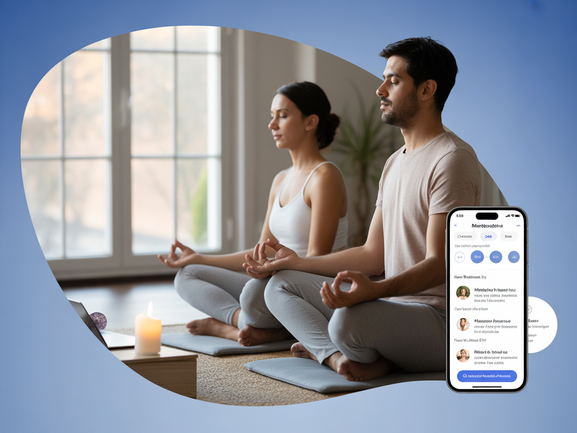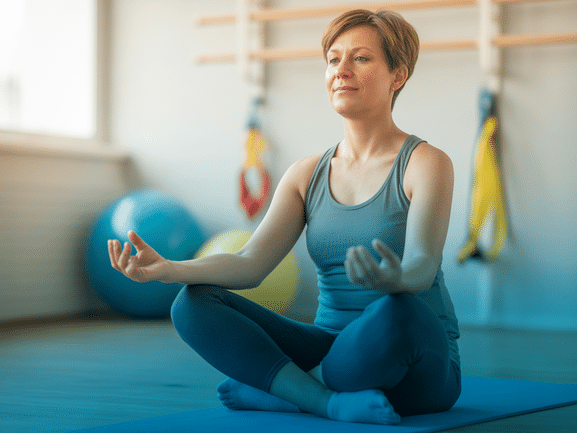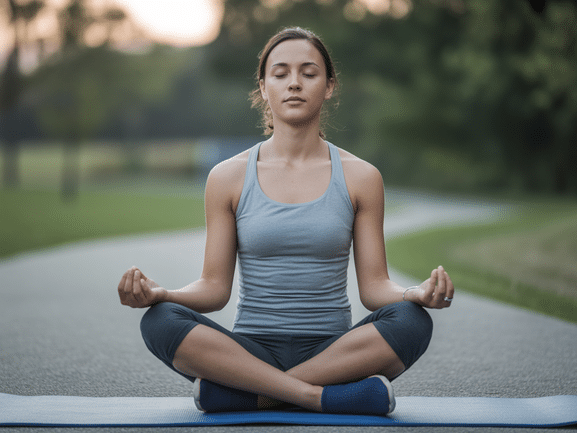Meditation for Anxiety: Your Practical Guide to Finding Calm in 2025
In our hyper-connected world, finding a moment of peace can feel like a luxury. With over 40 million adults in the U.S. grappling with anxiety, the need for effective, accessible tools for mental well-being has never been greater. Meditation for anxiety offers a powerful and science-backed solution. It’s a mental training practice that teaches you to focus your awareness, observe your thoughts without judgment, and anchor yourself in the present moment.
This guide provides a comprehensive look at how you can use meditation for anxiety to reclaim your inner peace. We will explore practical, step-by-step techniques, delve into the science behind how it works, and offer actionable tips updated for 2025 to help you build a lasting and transformative practice.
Understanding the Science: How Meditation Rewires the Anxious Brain
To appreciate the power of meditation for anxiety, it’s helpful to understand what happens in your brain during stress. When you perceive a threat, your amygdala—the brain’s “fear center”—triggers the fight-or-flight response, flooding your body with stress hormones like cortisol. For those with anxiety, this system can be overactive.
Meditation directly counteracts this process. Consistent practice strengthens the prefrontal cortex, the area of the brain responsible for emotional regulation and rational decision-making. This helps you respond to stressors more thoughtfully instead of reacting instinctively.
“According to groundbreaking research from the American Journal of Psychiatry (2025), brain imaging studies show that 12 weeks of regular meditation can tangibly decrease the size of the amygdala. This neurological shift demonstrates that meditation is a long-term strategy for building resilience.”
This shows that using meditation for anxiety isn’t just about feeling good in the moment; it’s about fundamentally changing your brain’s structure and response patterns for lasting calm.

How to Start: 5 Simple Meditation Techniques for Anxiety Relief
Beginning your meditation journey is simpler than you might think. You don’t need special equipment or hours of free time. Here are five detailed, step-by-step techniques perfect for beginners looking to practice meditation for anxiety.
1. Foundational Breathing (The 4-7-8 Technique)
When anxiety spikes, your breath becomes shallow and rapid. Focused breathing is the fastest way to activate your body’s relaxation response. This technique acts as an emergency brake for stress.
- Find a comfortable seated or lying position. Close your eyes gently.
- Exhale completely through your mouth, making a whoosh sound.
- Close your mouth and inhale quietly through your nose for a count of four.
- Hold your breath for a count of seven.
- Exhale completely through your mouth for a count of eight.
- This completes one cycle. Repeat the process three to five times, focusing only on the rhythm of your breath.
2. Body Scan Meditation
This practice grounds you in the present by connecting you with your physical self. It’s an excellent form of meditation for anxiety as it helps release stored physical tension you might not even be aware of.
- Lie down comfortably on your back, with your arms at your sides and palms facing up.
- Bring your attention to the toes on your left foot. Notice any sensations—warmth, coolness, tingling—without judgment.
- Slowly move your focus up your left leg, to your calf, knee, and thigh, observing each part.
- Repeat the process with your right leg, then move through your torso, arms, neck, and face.
- If your mind wanders, gently guide it back to the part of the body you are scanning.
3. Loving-Kindness Meditation
Anxiety is often accompanied by a harsh inner critic. This meditation practice helps dissolve self-criticism and cultivates compassion, rewiring your brain for kindness and reducing negative thought loops.
- Sit in a comfortable position and close your eyes. Take a few deep breaths.
- Silently repeat compassionate phrases directed toward yourself. For example: “May I be happy. May I be healthy. May I be safe. May I live with ease.”
- Next, bring to mind a loved one and repeat the phrases for them: “May you be happy. May you be healthy…”
- Extend these wishes to a neutral person, then to a difficult person, and finally to all living beings everywhere.
4. Mindful Walking Meditation
If sitting still feels like a challenge, a walking meditation for anxiety is a fantastic alternative. It combines gentle movement with mindful awareness, helping to calm a restless mind.
- Find a quiet place where you can walk back and forth, either indoors or outdoors.
- Begin walking at a slow, natural pace. Pay full attention to the physical sensations of walking.
- Notice the feeling of your feet lifting and touching the ground. Observe the subtle shifts in balance and the movement in your legs and body.
- When your mind wanders, gently return your focus to the sensation of walking. The goal isn’t the destination, but the journey of each step.
5. Mindful Observation
This simple technique anchors you firmly in the present moment by focusing your attention on a single object. It provides a much-needed break from the relentless cycle of anxious thoughts.
- Choose a small, everyday object, such as a pen, a leaf, or your own hand.
- Hold the object and give it your full attention. Observe it as if you were seeing it for the first first time.
- Notice its colors, textures, shape, and weight. Explore every detail, curve, and imperfection.
- If thoughts about the object arise (e.g., “this is an old pen”), simply acknowledge them and return your focus to pure observation.
💡 Ready to deepen your practice? The Vitalizen App offers guided sessions for each of these techniques. Download it today to start your journey with expert support!
Overcoming Common Hurdles in Your Meditation Practice
It’s normal to face challenges when you start practicing meditation for anxiety. Recognizing them as part of the process is the first step to overcoming them.
- “I can’t stop thinking!”: This is the most common misconception. The goal of meditation is not to empty your mind, but to notice your thoughts without getting carried away by them. Simply observe them and gently guide your focus back to your anchor (like your breath).
- Restlessness and Fidgeting: If you struggle to sit still, try a walking meditation or some gentle stretches before you begin. It’s okay to move; just do it mindfully.
- Falling Asleep: If you often feel drowsy, try meditating in a seated position with an upright posture rather than lying down. Meditating in the morning can also help.
- Finding Time: Start small. Even 5 minutes a day is incredibly beneficial. Consistency is far more important than duration. Link your practice to an existing habit, like your morning coffee, to make it stick.
Comparing Meditation Techniques for Anxiety
Different situations call for different tools. Understanding the primary goal of each technique can help you choose the most effective meditation for anxiety at any given moment.
| Technique | Primary Goal | Best For | Difficulty |
|---|---|---|---|
| Breathing Exercises | Immediate Calm | Panic attacks, sudden stress | Low |
| Body Scan | Physical Relaxation | Releasing bodily tension, before sleep | Low |
| Loving-Kindness | Emotional Healing | Self-criticism, feelings of anger | Medium |
| Walking Meditation | Active Grounding | Restlessness, connecting with nature | Low |
How Much Does Meditation for Anxiety Cost?
One of the most significant benefits of meditation for anxiety is its accessibility. You can begin a profound and effective practice with zero financial investment. Core techniques like mindful breathing, body scans, and mindful observation require only your attention and a quiet space.
For those who prefer structured guidance, many free resources are available on platforms like YouTube. However, a dedicated app like the Vitalizen App | Yoga + Meditation can accelerate your progress with personalized programs, progress tracking, and a vast library of sessions tailored to anxiety relief. While premium apps involve a subscription, they offer a curated and supportive environment for growth.
Frequently Asked Questions (FAQ)
How long should you meditate for anxiety?
For beginners, starting with just 5 to 10 minutes a day is highly effective. Consistency is more important than duration. As you build the habit, you can gradually increase the time. The goal is to create a sustainable practice that fits your lifestyle.
Can meditation replace therapy for anxiety?
Meditation is a powerful tool for managing anxiety symptoms but should be viewed as a complementary practice, not a replacement for professional therapy. For severe anxiety disorders, consulting a qualified mental health professional is crucial. Authoritative resources like the National Institute of Mental Health provide further guidance. Another great resource is the Anxiety & Depression Association of America (ADAA).
What is the best time to meditate for anxiety?
The best time to meditate is whenever you can consistently fit it into your schedule. Many people prefer meditating in the morning to set a calm tone for the day, while others find it helpful in the evening to de-stress before sleep. Experiment to find what works best for you.
Your Path to a Calmer Mind Starts Now
Embarking on a meditation for anxiety practice is a profound act of self-care. By integrating these mindfulness techniques into your life, you are taking a significant step toward lasting relief and resilience. Remember to be patient and compassionate with yourself as you learn. Every session, no matter how short, is a victory.
🎯 Ready to take the next step? Start your wellness journey now and discover how our tailored programs can help you manage anxiety. Curious about our mission? Learn more about what Vitalizen.app is. For more tips, explore our other articles, news, tips, and guidance on yoga and meditation.



